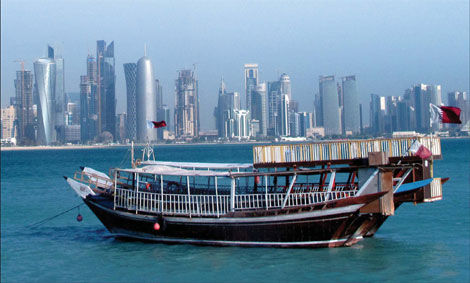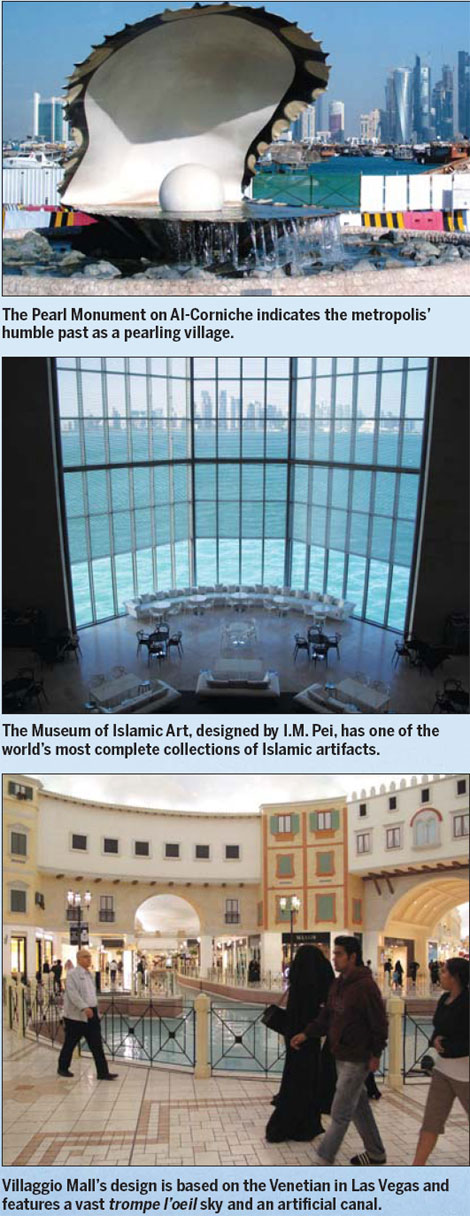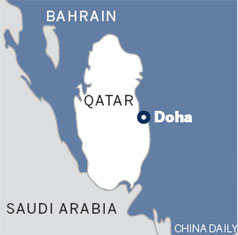Miracle & mirage
 |
|
The skyline of Doha's West Bay is dominated by skyscrapers. Photos by Mu Qian / China Daily |

It's hard to find locals in surreal Doha, the capital of Qatar, which ranks as the world's No 1 in per-capita GDP. Mu Qian explores further.
One of the first sights you see when landing at Doha International Airport is the skyline of West Bay, a waterfront of skyscrapers reminiscent of New York's Manhattan or Shanghai's Lujiazui but with a more surreal feel. From the airport, West Bay looks like an illusion created by a mirage. Get up close, and you will find a group of buildings with quirky architecture that seems to have emerged from nowhere, such as the thermos-shaped Doha Tower designed by Jean Nouvel and the pyramidal Sheraton Hotel. Nothing indicates Doha's previous incarnation as a pearling village, except the Pearl Monument on Al-Corniche. "People don't like old things here," says Mansour Mechmech, a sales executive of Kempinski Residences &Suites, one of the high-rises in West Bay. "Old houses have been demolished to make room for the new."
Mechmech, who is from Morocco, was leading us on a tour of the hotel's Premier Duplex Sky Villa. Located on the 61st and 62nd floors, this 1,062-square-meter villa offers everything from a private suite elevator to a maid's quarter. One of the many bathrooms has a jacuzzi facing a French window through which one can view the Gulf while having a bath.
Members of the royal family or entrepreneurs usually patronize the villa.

The surreal feel of Doha became even more pronounced when we visited Villaggio Mall. Designed after the Venetian in Las Vegas, it features a vast trompe l'oeil sky and an artificial canal, in which gondoliers wait to take people on gondola trips. There is a promotional film about the mall that is justly titled Gondolas in the Desert.
As if determined to make whatever seems impossible possible, besides gondolas in the desert, Villaggio's designer also included an ice rink in a city where it is not uncommon for temperatures to hit 50 C in summertime.
In this mall that often looks like a computer rendering, ceilings of different shades of blue recreate the sky at different moments of the day.
It will take a whole day if you want to scrutinize the 200 or so shops in Villaggio. But visitors to the mall - from Arabic women in batoola masks to Southeast Asians wearing T-shirts, and Westerners in business suits - were, to me, more interesting than the likes of Apple stores, Starbucks and Mont Blanc.
From a tourist's point of view, Doha is not an exciting place. Most of its sites can be covered in a day or two. A must-see is the Museum of Islamic Art.
Inaugurated in 2008, the museum was designed by Chinese-American architect I.M. Pei, who traveled throughout the Muslim world for six months to learn about Islamic architecture for the project.
The primary inspiration for the museum is said to have come from the ablutions fountain in the Mosque of Ahmed Ibn Tulun in Cairo. But one can still find traces of Pei's personal style in the museum, as seen in his other works, such as the Louvre Pyramid and Suzhou Museum.
For me, the most unique part of the Museum of Islamic Art is its top, which reminds one of an Arab woman's face in a veil, with two crescent windows serving as her eyes.
The museum has one of the world's most complete collections of Islamic artifacts, with items like manuscripts, ceramics, textiles, wood and precious stones from three continents, including a Mughal Indian jade jar from the collection of Chinese emperor Qianlong (who reigned from 1736-1795) that's inscribed with his own poetry.
However, there are no items from Qatar. Those are stored to be exhibited at the new grandiose National Museum of Qatar scheduled to open in December 2014.
In the park that surrounds the Museum of Islamic Art, a sculpture has been recently erected. Created by American artist Richard Serra and named 7, this work made of seven rusty steel plates looks like a beacon in the gulf and reaches 24 meters into the air.
Behind the curtain of these art projects is the Qatar Museums Authority, whose ambition is to become a "global leader in the world of museums, art and heritage".
Art is not the only area in which Qatar wants to play a leading role. The country will host the FIFA World Cup in 2022 and is bidding for the 2020 Olympic Games.
Once a backwater in the Gulf, Qatar now ranks No 1 on the 2011 chart of per-capita GDP compiled by the International Monetary Fund. Though smaller than Beijing, Qatar is forging a new identity as a country to be reckoned with.
On our way back from a four-wheel-drive tour to the dunes and beach, Mesaieed appeared to be a featureless desert. But I was told it is here that the main Qatar Petroleum plants are located and where the money for all the extravagant projects comes from.
Camels could be seen occasionally in the desert but primarily attract tourists rather than function in their traditional role of beasts of burden. The traditional nomadic lifestyle of Bedouins is no longer practiced since oil production and revenues moved Qatar out of the ranks of the world's poorest countries to the richest in the 1970s.
How do Qatari people feel about these changes to their lives? I didn't get a chance to ask any Qatari this question because I simply didn't really meet any Qataris. I was greeted by Filipino waitresses every day at the hotel, took taxis driven by Pakistanis or Eritreans, haggled with a Nepalese stall owner, and talked to an Italian and a Chinese citizen who work there.
Qataris only account for 20 percent of the country's resident population of 1.5 million, and there are large numbers of immigrants. Even the Arabs you see in the streets are often from other Arab countries.
A few days are enough for sightseeing in Qatar but not enough to understand its society, just as the kitsch items sold at Doha's Souq Waqif do not represent Arab art.
I resorted to Qatari Voices, an anthology of writings by a young generation of Qataris that I bought in a bookstore, to get a glimpse into the mindset of the country's people.
Authors of the book probe various aspects of Qatari life, where the new clashes with the old lifestyle. Take for instance, the appearance of mixed-gender schools, the undermining of the Arabic language because of the increasing use of English, and the introduction of a university course called "The problem of God", which teaches about a variety of religions other than Islam.
"Can we keep our hearts rooted to our values and our culture, and still be modern?" asks Saad Rashid al Matwi, a senior at Carnegie Mellon University in Qatar.
Commenting on the custom of arranged marriages, young lawyer Mohammed M al Khater says: "I understand the importance of preserving our traditions and values, but I also understand that some of these traditions no longer make sense because they simply do not work anymore. The new generation is enlightened and has seen more. It expects more."
On my last night in Doha, I spent my remaining rials at the Jazz Club in the Oryx Rotana hotel. Alcohol is legal at bars in international hotels but not outside.
While enjoying a glass of Johnnie Walker to the accompaniment of live jazz music played by a multinational band, I noticed an announcement at the bar: "Jazz Club enforces a dress code policy that restricts traditional dress."
In the dark, it was difficult to tell the nationalities of the audience, whose members all wore Western-style clothes. But I was sure there were Qataris among them, and I was eager to talk to them.














